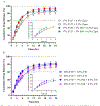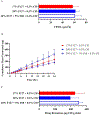Sprayable ciprofloxacin-loaded poloxamer hydrogels for wound infection treatment
- PMID: 37928051
- PMCID: PMC10624398
- DOI: 10.1016/j.jddst.2023.105000
Sprayable ciprofloxacin-loaded poloxamer hydrogels for wound infection treatment
Abstract
Topical antimicrobial treatments for severe burns and chronic wounds provide effective treatment against infections, but cause pain and discomfort with application. This study aimed to develop an antimicrobial topical formulation comprising thermoreversible poloxamers (Pluronic F127 and F68) and a broad-spectrum antimicrobial agent (ciprofloxacin hydrochloride, CH), that could be sprayed to eliminate application pain while maintaining antimicrobial activity. Formulations were characterized to determine their sprayability under cold conditions, gelation temperature, final storage modulus at skin temperature, drug release profile, ex vivo permeation through impaired porcine skin, and inhibition against common bacterial pathogens that colonize wounds. All cold formulations were sprayable from simple hand-held, pump-action sprayers due to their low viscosity. Upon heating, 17 and 20% Pluronic F127 formulations produced hydrogels eight to ten degrees below skin temperature, independent of ciprofloxacin loading. Increasing concentrations of Pluronic F127 increased the final storage modulus and viscosity of the gels, while inclusion of Pluronic F68 reduced these properties, showing that hydrogel rheological properties at skin temperature can be tuned via choice of formulation. Drug release was directly correlated to the rheological properties, with stiffer gels resulting in a decrease in drug release rate. Overall, gels released about 65-90% of their load within 12 hours. Ex vivo skin permeation demonstrated that drug was well retained in impaired porcine skin, which is desired to continuously treat bacteria localized to the wound. A well-diffusion assay indicated that the hydrogels had greater bacterial inhibition against Pseudomonas aeruginosa, Escherichia coli, and two strains of Staphylococcus aureus when compared to commercial controls. Overall, the results show the potential of CH-loaded poloxamer formulations as suitable sprayable topical dressings to deliver antimicrobials directly to wounds.
Keywords: antimicrobial; drug release; hydrogel; poloxamer; skin permeation; spray pattern.
Conflict of interest statement
Declaration of competing interest None
Figures










Similar articles
-
Spray coverage analysis of topical sprays formed by cold thermoreversible hydrogels.Drug Dev Ind Pharm. 2023 Jul;49(7):456-466. doi: 10.1080/03639045.2023.2229919. Epub 2023 Jul 10. Drug Dev Ind Pharm. 2023. PMID: 37354008 Free PMC article.
-
Novel Sprayable Thermosensitive Benzydamine Hydrogels for Topical Application: Development, Characterization, and In Vitro Biological Activities.AAPS PharmSciTech. 2023 Oct 17;24(8):214. doi: 10.1208/s12249-023-02674-w. AAPS PharmSciTech. 2023. PMID: 37848623
-
Release of a wound-healing agent from PLGA microspheres in a thermosensitive gel.Biomed Res Int. 2013;2013:387863. doi: 10.1155/2013/387863. Epub 2013 Oct 3. Biomed Res Int. 2013. PMID: 24224161 Free PMC article.
-
Propolis organogel as a novel topical delivery system for treating wounds.Drug Deliv. 2014 Feb;21(1):55-61. doi: 10.3109/10717544.2013.847032. Epub 2013 Dec 3. Drug Deliv. 2014. PMID: 24295500
-
Progress in Pluronic F127 Derivatives for Application in Wound Healing and Repair.Int J Nanomedicine. 2023 Aug 7;18:4485-4505. doi: 10.2147/IJN.S418534. eCollection 2023. Int J Nanomedicine. 2023. PMID: 37576462 Free PMC article. Review.
Cited by
-
Design and Development of a Sprayable Hydrogel Based on Thermo/pH Dual-Responsive Polymer Incorporating Azadirachta indica (Neem) Extract for Wound Dressing Applications.Polymers (Basel). 2025 Aug 7;17(15):2157. doi: 10.3390/polym17152157. Polymers (Basel). 2025. PMID: 40808205 Free PMC article.
-
Wound healing properties and antibiofilm activity of hydrogel matrix containing nitric oxide, silver nanoparticles, and ciprofloxacin against Pseudomonas aeruginosa burn wound infection.Sci Rep. 2025 Jul 21;15(1):26508. doi: 10.1038/s41598-025-12385-w. Sci Rep. 2025. PMID: 40691256 Free PMC article.
References
-
- Gomaa SF, Madkour TM, Moghannem S, and El-Sherbiny IM, “New polylactic acid/cellulose acetate-based antimicrobial interactive single dose nanofibrous wound dressing mats,” International Journal of Biological Macromolecules, vol. 105, pp. 11481160, 2017/12/01/ 2017, doi: 10.1016/j.ijbiomac.2017.07.145. - DOI - PubMed
Grants and funding
LinkOut - more resources
Full Text Sources

